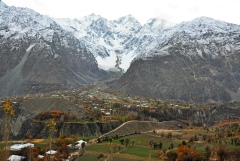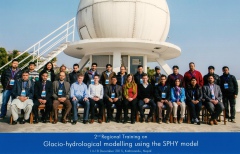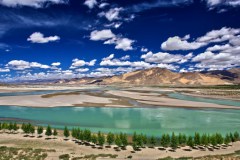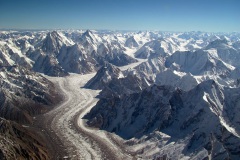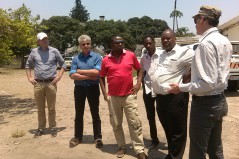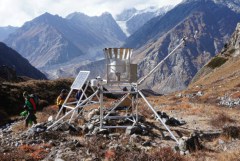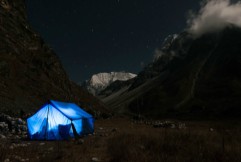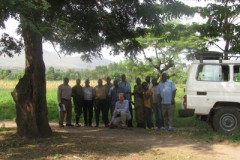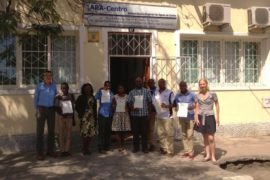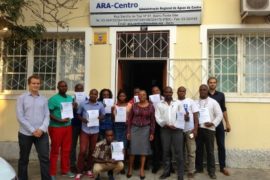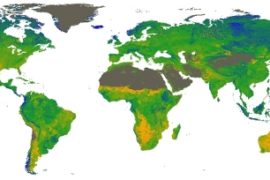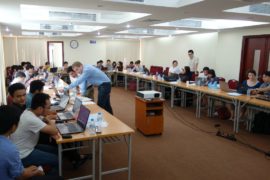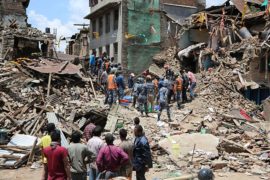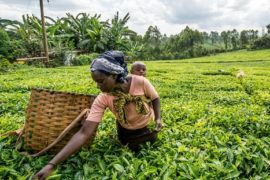News in 2015
22 December 2015
Himalayan snowfall underestimated
The amount of snow and rain in the Himalaya is about twice as high as commonly assumed. Research in the Indus basin by scientists from Utrecht University, FutureWater and the International Centre for Integrated Mountain Development (ICIMOD) led to the discovery. These findings have important bearing for water management and climate change impact assessments. The...
22 December 2015
Second regional training on glacio-hydrological modeling using the SPHY model in Kathmandu, Nepal
The Hindu Kush-Himalayan region is highly dynamic as there are many socio-economic and environmental drivers at play, including climate change. The impacts of these changes challenge the resilience of natural and human capacities and environments in the region. Recent studies have shown that the Himalayan region and the downstream areas that depend on its water...
9 December 2015
Launch of The Himalayan Climate and Water Atlas at COP21
On 11 December the HKH Water Atlas (‘The Himalayan Climate and Water Atlas: Impact of Climate Change on Water Resources in Five of Asia’s Major River Basins’) will be launched at the 2015 United Nations Climate Change Conference (COP21). The conference is held in Le Bourget, Paris, France from 29 November to 11 December. The...
9 December 2015
FutureWater and partners kick off IMPREX project
To advance the state-of–the-art in operational hydro-meteorological forecasting, a newly funded project called IMPREX has recently been launched. IMPREX stands for: IMproving PRedictions and management of hydrological EXtremes. The project, awarded €7.9 million over 4 years by the European Commission, aims to improve society’s ability to anticipate and respond to future hydrological extreme events in...
7 December 2015
Open webinar on the impact of climate change on the Asian Water Towers
The high mountain ranges in Asia are also called the Asian Water Towers, providing water resources for the densely populated downstream areas, where millions of people depend on the water coming from upstream. The water generated in the high Asian mountains feeds into the world’s largest irrigation schemes and reservoirs. Downstream water demands are high,...
30 November 2015
Expanding the Third Eye project in Mozambique
The Third Eye project has been operational now for a few months in the regadios, irrigation schemes of Chokwe (HICEP) and Xai Xai (RBL). During the past weeks our field officer, Jan van Til, was in Mozambique to monitor the project progress and to acquire new partnership and collaborations. Jan visited 4 flying sensor operators...
12 November 2015
HI-AWARE training for the use of High Altitude Monitoring equipment
FutureWater co-organized a training course for HI-AWARE team members in the use high-altitude monitoring equipment at Koenders Instruments in the Netherlands. Participants from ICIMOD, PARC, PMD, TERI and FutureWater met during 3rd November until 6th November at Koenders Instruments in the Netherlands to be trained in the installation and operation of various hydrometeorological equipment, which...
10 November 2015
Resuming research in Nepal after the earthquake
Dr. Walter Immerzeel participated in an expedition to the Langtang region in October 2015 together with a group of scientists and a journalist from ICIMOD. It was the first time after the earthquake in April 2015 for the scientists to return this area, where they have been working for the past few years. It was...
6 October 2015
Launch of InfoSequía.es: Web-portal on the drought status of the Iberian Peninsula
FutureWater launches InfoSequia, a website with data updates on the drought status of the Iberian Peninsula. InfoSequía provides weekly drought bulletins with maps of satellite-based drought indices that complement hydrological drought indices used by Spanish Water Basin Authorities. In Spain drought management is regulated by Law 10/2001 of the National Hydrological Plan which requires: 1)...
17 September 2015
Pilot study started for a Payment for Watershed Services Scheme in Uganda
Last week FutureWater participated in the inception meeting organized by WWF in Uganda, on the Hydrological and Agronomic Study for a Payment for Watershed Services Scheme in Rwenzori Mountains National Park, Uganda. This is a pilot study within a larger project coordinated by WWF, called “Sustainable Financing of the Rwenzori Mountains National Park (SFRMNP) Project”...
23 August 2015
Successful second training week in Water Allocation Modeling in Mozambique
During the week of 3-7 August, training in Water Allocation Modeling (using WEAP) was provided to 3 ARAs (water boards) in Mozambique, being ARA-Centro, ARA-Centro-Norte, and ARA-Norte. This training was funded by NUFFIC’s Tailor-Made Training Programme, which is part of the Netherlands Fellowship Programmes (NFP II), and is specifically meant to enhance the overall functioning of...
17 August 2015
Successful first training week in Water Resources Modeling in Mozambique
During the week of 27-31 July, training in Water Resources Modeling (using SPHY) was provided to 3 ARAs (water boards) in Mozambique, being ARA-Centro, ARA-Centro-Norte, and ARA-Norte. This training was funded by NUFFIC’s Tailor-Made Training Programme, which is part of the Netherlands Fellowship Programmes (NFP II), and is specifically meant to enhance the overall functioning...
31 July 2015
FutureWater’s Global Maps of Soil Hydraulic Properties Available
FutureWater has developed global maps of soil hydraulic properties to support hydrological modelling. The maps, at a resolution of 1 km world-wide, are now available. The maps are produced by combining the best soil information at global scale and most up-to-date pedo-transfer functions currently available. Soil information is the basis for all environmental studies. Since...
8 July 2015
SPHY v2.0 published in Geoscientific Model Development
In response to various water-related challenges, FutureWater and its partners have developed the Spatial Processes in HYdrology (SPHY) model and applied the model in various research projects. SPHY is a state-of-the-art, easy to use, robust tool, that can be applied for operational as well as strategic decision support. We are now proud to announce that...
12 June 2015
ThirdEye project website now online: ThirdEyeWater.com
Farmers are confronted with a lack of knowledge on where and when to apply their limited resources as water, fertilizer, and seeds. A key factor in enabling an increase and efficiency in food production is providing farmers with relevant information. Such information is needed as farmers have limited resources (seed, water, fertilizer, pesticides, human power)...
4 June 2015
Successful SPHY training provided to Vietnamese water professionals in Hanoi
On June 2, 2015, Thuy Loi University in Hanoi hosted a short course for professionals from Vietnamese organizations to transfer knowledge and technology on water resources modelling. This training for professionals was organized in the framework of the NICHE project Improvement of higher education in water management in view of climatic change in Vietnam, financed...
21 May 2015
Upcoming training course: Water resources modelling using the SPHY-model (October 2015)
In October 2015 FutureWater offers a training course on water resources modelling using the Spatial Process in Hydrology (SPHY) model in Wageningen, the Netherlands. In response to various water-related challenges, FutureWater and its partners have developed the Spatial Processes in HYdrology (SPHY) model and applied the model in various research projects. SPHY is a state-of-the-art, easy to use,...
1 May 2015
Earthquake Nepal: Post-event risk and impact assessments
The magnitude 7.8 Gorkha earthquake that struck Nepal on April 25, 2015, caused extensive damage in Kathmandu Valley and severely affected Nepal’s rural areas. The Langtang Valley in the Rasuwa district was particularly hard hit, as became apparent after pictures taken by a rescue helicopter mission on April 26 (link). Numerous tourists and Nepali were,...
20 March 2015
Africa’s first Water Fund to Combat Rising Threats to Food Security, Water and Energy Supplies
This press note was released by The Nature Conservancy and covered by various media (as Reuters, SciDev, interview at CNBC). More info on the project, check our project page. The Kenya government, businesses, conservation groups and utilities launched Africa’s first Water Fund today. The Fund is designed to provide a sustained water supply to a...
2 March 2015
FutureWater in Workshop on Water Management and Rainfed Agriculture in the MENA Region
FutureWater has participated in a workshop on Water Management and Rain Fed Agriculture in the Middle East and North Africa (MENA) region, organized by Humboldt Universität zu Berlin, and the German Jordan University. The purpose of the workshop was to strengthen research efforts on this very relevant topic. Several researchers from European and North African...
20 February 2015
SPHY model published in Geoscientific Model Development “Discussions”
In response to various water-related challenges, FutureWater and its partners have developed the Spatial Processes in HYdrology (SPHY) model and applied the model in various research projects. SPHY is a state-of-the-art, easy to use, robust tool, that can be applied for operational as well as strategic decision support. We are now proud to announce that...
29 January 2015
Spatial Processes in Hydrology (SPHY) model website online
Since 2011 FutureWater is developing the Spatial Processes in Hydrology (SPHY) model: a distributed hydrological model which is used in a wide range of applications worldwide. SPHY is used successfully in many of our projects including climate change impact studies, water and energy applications, irrigation management and operational services. A new website is launched for...
